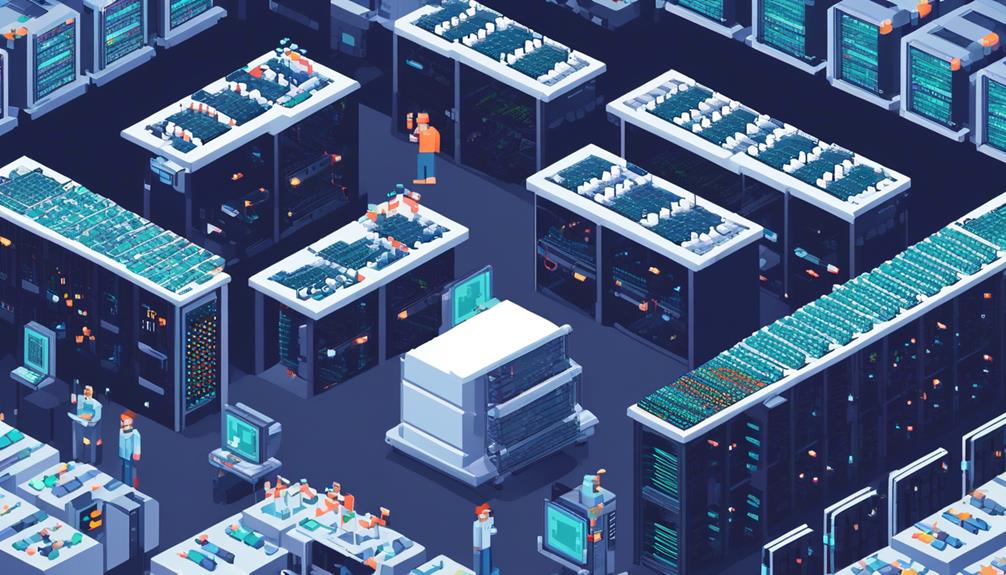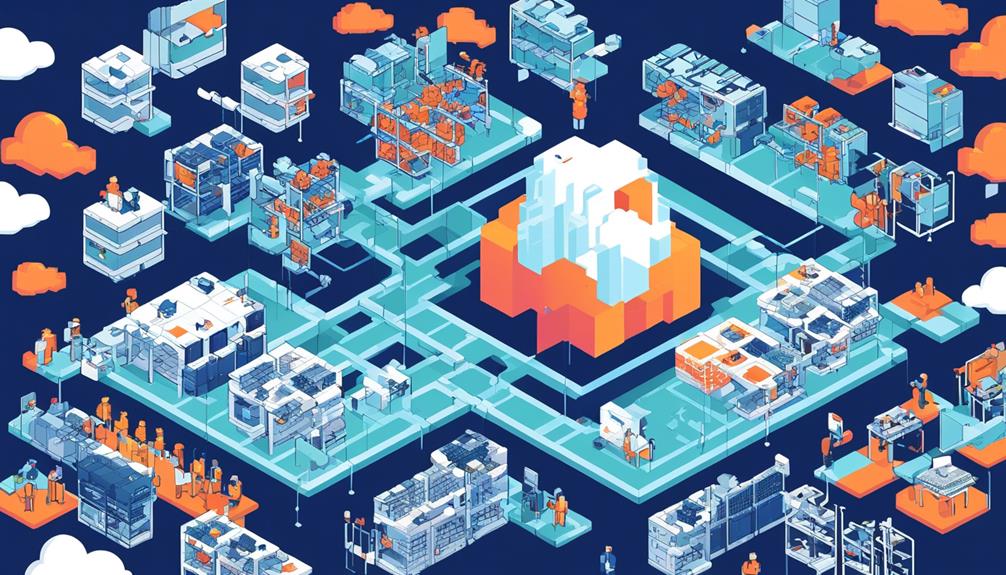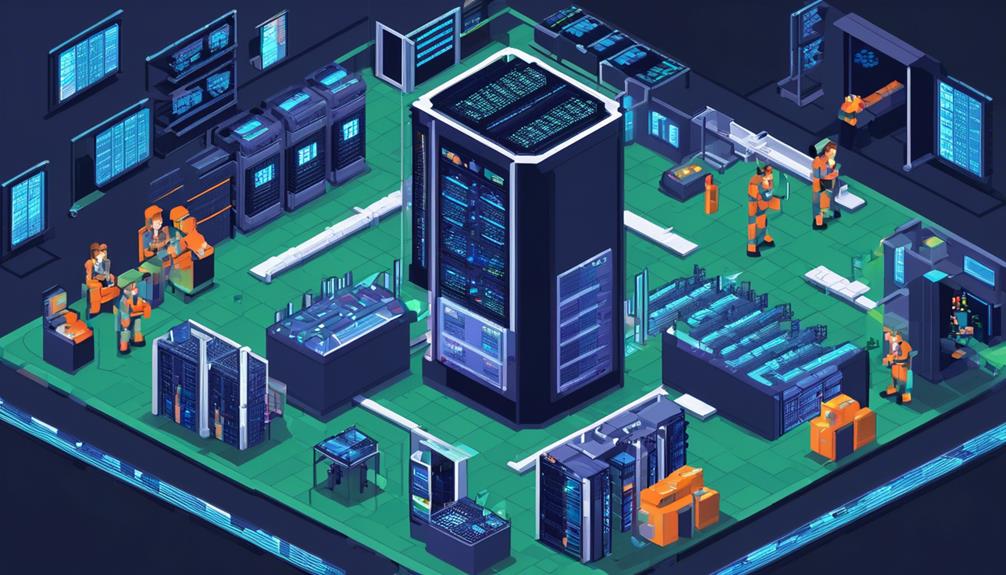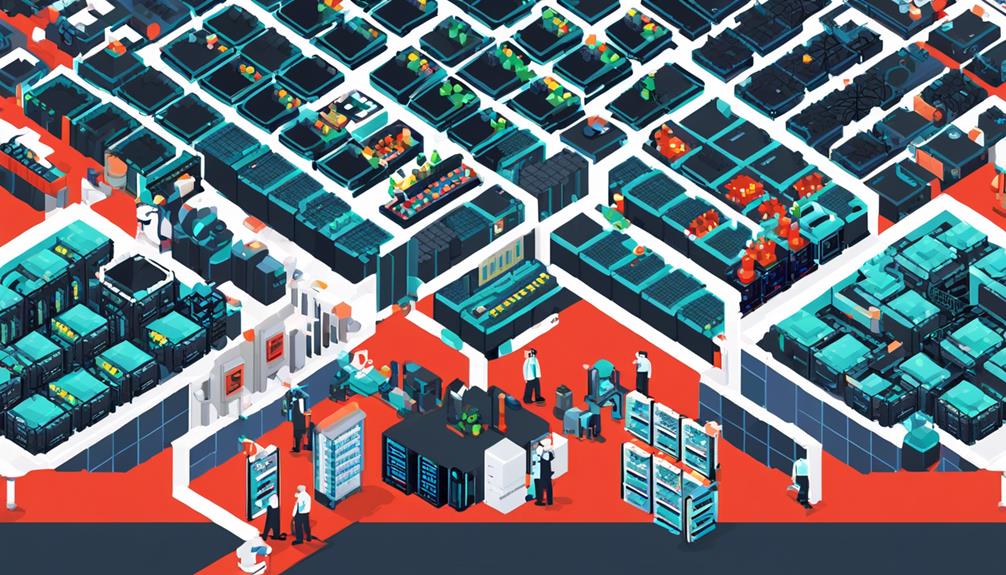Disaster recovery in data centers is a critical aspect of ensuring business continuity and the protection of valuable data. With the increasing complexity and frequency of disasters, traditional manual recovery methods are becoming inadequate.
This is where Artificial Intelligence (AI) comes into play, revolutionizing the way data centers recover from disasters. By leveraging AI's capabilities, data centers can now automate the entire disaster recovery process, from identifying potential risks to implementing timely and effective actions.
In this discussion, we will explore the various ways in which AI enables disaster recovery in data centers, the benefits it brings, and its potential future implications. Get ready to uncover the transformative power of AI in the realm of disaster recovery and discover how it can revolutionize the way data centers handle crisis situations.
Key Takeaways
- AI-driven workload management in data centers optimizes resource allocation and utilization, leading to improved efficiency and reduced operational costs.
- AI algorithms proactively detect anomalies and predict potential failures, minimizing downtime and ensuring prioritization of critical workloads during recovery efforts.
- Real-time monitoring of data center performance, facilitated by AI, enhances service quality and minimizes the risk of data breaches or cyberattacks.
- AI enables organizations to adapt to changing demands and implement innovative solutions, revolutionizing disaster recovery and resource management in data centers.
Ai-Driven Workload Management

Ai-Driven Workload Management is a cutting-edge approach that leverages artificial intelligence (AI) to optimize resource allocation and utilization in data centers. This innovative technique utilizes predictive analytics to automate and streamline day-to-day operations in managing workloads. By harnessing the power of AI, data centers can significantly improve efficiency in workload management and allocation, resulting in reduced operational costs.
One crucial aspect of disaster recovery planning in data centers is workload management. Data centers handle large volumes of data and complex machine learning algorithms. Efficiently managing workloads is essential to ensure the smooth functioning of operations and minimize downtime during a disaster. AI-driven workload management facilitates dynamic workload management, enabling data centers to respond effectively to changing demands and improve service quality while reducing costs.
AI-driven workload management is particularly valuable in disaster recovery planning. It enables data centers to allocate resources intelligently, ensuring critical workloads are prioritized during recovery efforts. By leveraging AI capabilities, data centers can automate the process of workload allocation and resource optimization, allowing for efficient handling of massive data processing. This proactive approach minimizes the risk of bottlenecks and ensures a swift recovery from a disaster.
Ensuring Business Continuity With AI
Efficiently managing workloads in data centers is crucial for disaster recovery planning, and AI plays a vital role in ensuring business continuity by optimizing resource management and enhancing security measures. By implementing AI in data centers, organizations can automate and streamline day-to-day operations through predictive analytics and operational decision-making.
Here are five ways AI enables business continuity in data centers:
- Workload management and allocation: AI algorithms can analyze historical data and real-time information to optimize workload distribution, ensuring that resources are efficiently utilized and preventing bottlenecks or overloads.
- Reduced downtime: AI can proactively detect anomalies and predict potential failures, allowing data center operators to take preventive measures to minimize downtime and ensure uninterrupted service availability.
- Enhanced service quality: AI's ability to analyze vast amounts of data enables real-time monitoring of data center performance. It can identify and resolve issues promptly, ensuring high-quality service delivery to customers.
- Improved security: AI-powered security systems can detect and analyze potential threats, minimizing the risk of data breaches or cyberattacks. It can also enhance data processing and storage security by identifying vulnerabilities and implementing robust encryption and access control mechanisms.
- Future readiness: As the future of data centers is shaped by AI, quantum computing, and emerging technologies, it is crucial for organizations to continually evolve and improve their infrastructure. AI can help in adapting to changing demands, optimizing resource usage, and implementing innovative solutions.
Enhancing Customer Experience Through AI

AI is revolutionizing the way businesses enhance customer experience by leveraging data analytics and personalization techniques. By analyzing vast amounts of data, AI can identify patterns, understand preferences, and personalize interactions to meet the unique needs of each customer. This not only improves satisfaction but also builds customer loyalty and drives business growth.
One way AI enhances customer experience is through the automation and streamlining of customer support processes. Machine learning algorithms can analyze customer inquiries and provide faster response times, leading to improved satisfaction. AI-powered chatbots are another tool that enhances customer experience by offering personalized recommendations, addressing customer queries, and providing round-the-clock support.
Predictive analytics, enabled by AI, can anticipate customer needs and enable businesses to proactively address issues. By identifying potential problems before they occur, businesses can tailor their offerings to meet specific customer requirements, resulting in a more personalized and satisfying experience.
Furthermore, AI can analyze customer feedback across various channels, providing valuable insights to improve products, services, and the overall customer journey. By understanding customer sentiment and preferences, businesses can make informed decisions to enhance their offerings and address any pain points.
Ai-Powered Data Center Security
Utilizing advanced AI algorithms, data center security is enhanced through the detection of anomalies in network traffic and system behavior. AI-powered data center security plays a crucial role in protecting the integrity, reliability, and uptime of data centers by proactively identifying potential threats and vulnerabilities. By continuously analyzing and learning from vast amounts of data, AI algorithms enable data centers to predict and prevent security breaches, ensuring efficient data processing and storage.
To provide a clearer understanding of AI-powered data center security, here are five key aspects:
- Automated Threat Detection: AI algorithms can quickly identify and respond to potential threats, such as malware, unauthorized access attempts, or abnormal network activities. By analyzing patterns and behaviors in real-time, AI-powered systems can alert security teams and initiate countermeasures promptly.
- Enhanced Incident Response: AI can streamline incident response by automatically identifying and prioritizing security incidents based on their severity. This enables security teams to allocate resources effectively and respond to incidents in a timely manner.
- Predictive Analytics: AI algorithms use historical and real-time data to predict potential security risks and vulnerabilities. By analyzing patterns and trends, AI can identify weak points in the data center's security infrastructure and recommend proactive measures to mitigate risks.
- Intelligent Access Control: AI-powered authentication systems can recognize and verify users based on their unique behavioral patterns, reducing the risk of unauthorized access. This ensures that only authorized personnel can access sensitive data and resources within the data center.
- Continuous Monitoring and Improvement: AI algorithms continuously monitor the data center's network traffic, system behavior, and security infrastructure, allowing for the timely detection of emerging threats. This enables data centers to stay ahead of evolving cyber threats and implement necessary security updates and enhancements.
Future of Data Centers and AI

With the integration of AI systems into data centers, the future of the industry is being shaped, revolutionizing operations, security, and resource management. AI is becoming increasingly crucial for data centers to provide effective, secure, and efficient services. The sheer volume of data being generated and processed requires AI systems to handle massive data processing and support complex machine learning algorithms.
One area where AI can greatly impact data centers is disaster recovery. AI-powered systems can analyze vast amounts of data in real-time, enabling data centers to detect anomalies and potential threats. This proactive approach allows for early detection and mitigation of risks, minimizing the impact of disasters on data center operations. By continuously monitoring data center infrastructure and identifying potential vulnerabilities, AI systems can enhance disaster recovery strategies and ensure business continuity.
In addition to disaster recovery, AI can optimize data center cooling systems, reducing operational costs and improving energy efficiency. By analyzing environmental data and predicting cooling demands, AI algorithms can dynamically adjust cooling configurations, ensuring optimal performance while minimizing energy consumption. This not only reduces costs but also contributes to sustainability efforts.
Looking to the future, advanced AI, quantum computing, and emerging technologies will shape the next generation of data centers. AI will continue to play a vital role in enhancing operations, security, and resource management. As the demands on data centers increase, AI systems will become even more sophisticated, enabling faster and more efficient data processing, improved security measures, and enhanced disaster recovery capabilities.
Continuous Surveillance of Cloud Infrastructure
Continuous surveillance of cloud infrastructure involves real-time threat detection, automated security monitoring, and proactive vulnerability identification. By utilizing AI-powered tools and techniques, this surveillance ensures the security, reliability, and optimal functioning of cloud-based systems and services.
It plays a critical role in minimizing downtime, data loss, and potential disasters, safeguarding the resilience and continuity of cloud-based operations.
Real-Time Threat Detection
Real-Time Threat Detection is a vital component of ensuring the robust security and integrity of cloud infrastructure through continuous surveillance. By leveraging AI technology, Real-Time Threat Detection enables the monitoring and analysis of network traffic, access logs, and system behavior to detect potential security risks and anomalies.
Here are five key features of Real-Time Threat Detection:
- Continuous monitoring: Real-Time Threat Detection constantly scans the cloud infrastructure for any suspicious activities or unauthorized access attempts.
- Anomaly detection: It identifies unusual traffic patterns and changes in data access, allowing for proactive security measures to be implemented promptly.
- Data redundancy identification: Real-Time Threat Detection helps identify redundant data, reducing storage costs and enhancing data security and integrity.
- Efficient compression algorithms: It uses efficient compression techniques to minimize storage requirements and improve disaster recovery efficiency.
- Cloud consulting services: Organizations can leverage Real-Time Threat Detection to stay ahead of emerging threats and ensure efficient disaster recovery in their data centers.
With Real-Time Threat Detection, data centers can enhance their security measures, mitigate potential risks, and ensure the continuity of their operations in the face of evolving threats.
Automated Security Monitoring
Automated Security Monitoring plays a crucial role in ensuring the robust security and integrity of cloud infrastructure. It provides continuous surveillance of network traffic, access logs, and system behavior. By leveraging AI, this monitoring system can effectively detect anomalies and potential threats in real-time.
It enables data centers to take proactive action against evolving cyber threats, enhancing data processing, storage, and security. With AI-enabled automated security monitoring, data centers can predict potential vulnerabilities and prioritize their disaster recovery efforts accordingly. This proactive approach greatly reduces the risk of data breaches and ensures the continuity of operations in data centers.
Proactive Vulnerability Identification
Proactive vulnerability identification through continuous surveillance of cloud infrastructure harnesses generative AI to detect anomalies and mitigate potential threats. By using advanced algorithms and machine learning techniques, this approach offers several benefits for disaster recovery in data centers:
- Identification of unusual traffic patterns or changes in data access, enabling prompt detection of potential security breaches.
- Efficient compression algorithms that identify weaknesses and potential catastrophes, allowing for proactive measures to prevent attacks.
- Ensuring data uniformity across hybrid cloud environments, enabling seamless backup and recovery operations between different cloud providers.
- Spreading out cloud resources to reduce the risk of a single point of failure, enabling quick and automatic failover and recovery operations between various cloud environments.
- Continuous learning and improvement of disaster recovery plans, ensuring they remain up-to-date and effective in the constantly evolving digital landscape.
Incorporating AI into proactive vulnerability identification enhances the security and resilience of data centers, enabling businesses to effectively respond to potential threats and minimize the impact of disasters.
Finding Redundant Data With AI
Utilizing advanced AI algorithms, data centers can efficiently identify redundant data by analyzing patterns and similarities within datasets. This application of AI in data centers is highly beneficial for optimizing storage usage and improving overall data center efficiency. By automating the process of identifying and eliminating redundant data, AI algorithms save valuable time and resources.
The use of AI in finding redundant data leads to more streamlined and cost-effective data storage solutions. By analyzing and categorizing data, AI can effectively identify and manage redundant data in data centers. This not only reduces storage costs but also improves data retrieval and disaster recovery processes.
To illustrate the efficiency of AI in finding redundant data, consider the following table:
| Dataset ID | Size (GB) | Redundant Data (GB) |
|---|---|---|
| 1 | 100 | 20 |
| 2 | 80 | 10 |
| 3 | 120 | 30 |
| 4 | 150 | 40 |
In this example, AI algorithms analyze the datasets and identify the redundant data within each dataset. By comparing patterns and similarities, AI can determine which portions of the data are redundant and can be eliminated. In this case, dataset 1 has 20GB of redundant data, dataset 2 has 10GB, dataset 3 has 30GB, and dataset 4 has 40GB.
Accurate Predictions for Disaster Recovery

Accurate predictions for disaster recovery leverage the power of generative AI to forecast, adapt, and automate effective plans in today's rapidly evolving digital landscape. By harnessing the capabilities of AI, data centers can enhance their disaster recovery strategies and ensure business continuity.
Here are five key ways in which accurate predictions using AI benefit disaster recovery efforts in data centers:
- Continuous surveillance: Generative AI excels at continuously monitoring cloud infrastructure, detecting anomalies, and identifying potential weaknesses. This proactive approach enables data centers to anticipate and address issues before they escalate into disasters.
- Redundant data detection: With efficient compression algorithms, generative AI can identify redundant data, reducing storage requirements and enhancing data center efficiency. This optimization not only saves resources but also improves disaster recovery operations by eliminating unnecessary data.
- Improved accuracy: Accurate predictions with generative AI enable data centers to have a better understanding of potential catastrophes and their potential impact. This knowledge aids in proactive planning, allowing data centers to implement effective measures to mitigate risks and minimize downtime.
- Seamless coordination: Generative AI ensures data uniformity across hybrid cloud environments, facilitating seamless backup and recovery operations between different cloud providers. This coordination streamlines disaster recovery processes and enhances overall efficiency.
- Multi-cloud resilience: By leveraging generative AI, data centers can implement multi-cloud disaster recovery strategies. This approach spreads out cloud resources, coordinates failover operations, and ensures business continuity through automatic crisis response. In the event of a disaster in one cloud provider, the workload seamlessly transitions to another, minimizing downtime and maintaining consistent service delivery.
Accurate predictions for disaster recovery using AI technology empower data centers to adapt, respond, and recover swiftly in the face of unforeseen events. By incorporating AI-driven forecasting and automation, data centers can enhance their disaster recovery plans and safeguard critical systems and data.
Cloud Hybrid Integration for Resilience
To ensure the seamless continuity of operations in data centers, Cloud Hybrid Integration for Resilience plays a crucial role in maintaining data uniformity and facilitating efficient backup and recovery operations across diverse cloud environments. This integration ensures that data remains consistent and accessible regardless of the cloud service provider being used. It continuously scans data for inconsistencies or conflicts, ensuring data integrity in a hybrid cloud setup.
Generative AI, with its ability to analyze and understand complex data patterns, plays a vital role in coordinating and executing disaster recovery across various cloud providers. It leverages AI algorithms to identify the most suitable cloud environment for backup and recovery operations, taking into account factors such as cost, performance, and availability. This AI-driven approach enables organizations to efficiently allocate resources and minimize downtime in the event of a disaster.
Cloud Hybrid Integration for Resilience also reduces the risk of a single point of failure by utilizing multiple cloud service providers. By distributing data and workloads across different cloud environments, organizations can ensure that their operations remain resilient even if a particular cloud provider experiences an outage or disruption.
To illustrate the benefits of Cloud Hybrid Integration for Resilience, consider the following table:
| Benefits of Cloud Hybrid Integration for Resilience |
|---|
| Ensures data uniformity across hybrid cloud environments |
| Facilitates efficient backup and recovery operations |
| Minimizes downtime and ensures business continuity |
| Reduces the risk of a single point of failure |
| Leverages AI algorithms for intelligent disaster recovery |
Multi-Cloud Disaster Recovery Solutions

Multi-cloud disaster recovery solutions involve leveraging multiple cloud service providers to create redundancy and resilience in disaster recovery planning, ensuring seamless continuity of operations in the event of a crisis. With the increasing reliance on cloud services for data storage and processing, organizations are recognizing the need to protect their data and applications from potential disasters.
Here are some key aspects of multi-cloud disaster recovery solutions:
- Generative AI for resource distribution: Generative AI can help businesses spread out their cloud resources to reduce the risk of a single point of failure in multi-cloud disaster recovery scenarios. By intelligently distributing workloads across different cloud environments, organizations can minimize the impact of a localized outage.
- Coordinating failover and recovery: Coordinating failover and recovery operations between various cloud environments is a key function of generative AI in multi-cloud disaster recovery solutions. AI algorithms can analyze real-time data and determine the most appropriate cloud environment for failover, ensuring that critical operations continue uninterrupted.
- Automated switching during crises: Generative AI can quickly and automatically act during a crisis to switch operations from one cloud to another, reducing downtime and ensuring business continuity in multi-cloud disaster recovery. This automated switching capability minimizes the reliance on manual intervention, enabling faster response times and reducing the risk of human error.
- Improved efficiency and effectiveness: Multi-cloud disaster recovery solutions with generative AI can improve the efficiency and effectiveness of disaster recovery and business continuity plans across different cloud environments. By leveraging AI algorithms, organizations can optimize their resource allocation, reduce costs, and ensure that critical services are prioritized during recovery operations.
- Flexibility and scalability: Multi-cloud disaster recovery solutions offer organizations the flexibility to choose from multiple cloud service providers, allowing them to tailor their disaster recovery strategies to their specific needs. This flexibility also enables scalability, as organizations can easily expand their cloud resources as their data and application requirements grow.
Ai's Role in Disaster Recovery Planning
Artificial intelligence (AI) plays a crucial role in disaster recovery planning by forecasting, adapting, and automating recovery plans to ensure adaptability in the rapidly changing digital environment.
AI technology, such as generative AI, has proven to be effective in enhancing disaster recovery strategies in data centers.
Generative AI is particularly useful in continuous surveillance of cloud infrastructure, as it can detect anomalies and efficiently compress redundant data. By accurately predicting potential disruptions, generative AI enables organizations to proactively address weaknesses and prepare for possible attacks. Furthermore, it provides valuable insights based on previous periods of downtime, facilitating better decision-making in disaster recovery planning.
In the context of multi-cloud disaster recovery planning, generative AI ensures data uniformity and coordinates failover and recovery operations. By minimizing downtime, it helps organizations maintain business continuity and minimize the impact of disruptions.
To optimize disaster recovery planning, it is important to incorporate AI in various aspects. This includes retraining AI models to adapt to evolving threats and changes in the digital landscape. Additionally, AI can be leveraged to store search indexes, improving the efficiency of data retrieval during recovery operations. AI also plays a significant role in enhancing protection, incident response, and business continuity planning.
Optimizing Resource Management With AI

AI technology plays a vital role in optimizing resource management in data centers. It enhances workload allocation and management, reduces downtime, improves service quality, bolsters security, and supports automation in business operations.
With AI-enabled disaster recovery systems, data centers can efficiently allocate and manage workloads by utilizing hardware and network services effectively.
Here are some ways AI optimizes resource management in data centers:
- Improved Workload Management: AI can analyze data center workloads and allocate resources based on their requirements, ensuring efficient utilization of hardware and network services. This helps in avoiding overutilization or underutilization of resources, leading to cost savings and improved performance.
- Predictive Maintenance: By leveraging AI algorithms, data centers can predict potential hardware failures and schedule preventive maintenance. This proactive approach reduces downtime and hardware replacement costs, ensuring smooth operations.
- Dynamic Workload Management: AI-based systems can dynamically adjust workload allocation based on real-time demand, optimizing resource utilization. This agile approach ensures that resources are efficiently distributed, reducing costs and improving service quality.
- Enhanced Security: AI can bolster data center security by continuously monitoring network traffic, access logs, and system behavior. By detecting anomalies and potential threats, AI systems can respond quickly and efficiently, minimizing the risk of security breaches.
- Automation: AI enables automation in various business operations, such as provisioning resources, managing workflows, and performing routine tasks. This streamlines processes, reduces manual intervention, and improves operational efficiency.
Ai-Enabled Data Center Operations
With the increasing demand for efficient resource management and enhanced security in data centers, the focus now shifts to Ai-Enabled Data Center Operations. These operations leverage advanced AI technologies to optimize resource management and enhance security in data centers specifically designed for AI workloads.
Ai-Enabled Data Center Operations utilize high-performance servers, storage systems, networking infrastructure, and specialized hardware accelerators to efficiently handle the demands of AI workloads. They automate and streamline day-to-day operations through predictive analytics, enabling data center administrators to make informed decisions regarding resource allocation and workload management.
One of the key advantages of Ai-Enabled Data Center Operations is their ability to optimize cooling systems for improved energy efficiency. By leveraging AI algorithms, these operations can dynamically adjust cooling systems based on real-time data, reducing energy consumption and minimizing costs.
To emphasize the benefits of Ai-Enabled Data Center Operations, consider the following table:
| Benefits of Ai-Enabled Data Center Operations |
|---|
| Efficient resource management |
| Enhanced security |
| Predictive analytics for proactive maintenance |
The implementation of AI in data centers is predicted to cost $76 billion by 2028, as organizations recognize its potential to drive efficiency, enable predictive maintenance, and facilitate dynamic workload management. Moreover, AI plays a crucial role in bolstering data center security by detecting anomalies, enabling proactive security measures, and protecting against evolving cyber threats.
AI and Machine Learning in Disaster Recovery

AI and machine learning are becoming increasingly integral in disaster recovery in data centers. By leveraging AI algorithms, data centers can automate processes, improve predictive analytics, and optimize resource management.
Machine learning techniques enable data centers to allocate workloads more efficiently, reduce downtime, and enhance overall security by detecting anomalies and predicting potential threats.
The integration of AI and machine learning in disaster recovery is transforming the field, ensuring continuous surveillance and efficient handling of changing demands in data centers.
AI in Data Recovery
The integration of artificial intelligence and machine learning has ushered in a new era of data recovery processes in data centers. With AI's capabilities, disaster recovery has become more efficient and effective. Here are some key ways in which AI is transforming data recovery:
- AI systems utilize machine learning models to analyze and interpret large amounts of data, enabling faster and more accurate recovery processes.
- Predictive analytics helps identify potential risks and vulnerabilities, allowing proactive measures to be taken for disaster prevention.
- AI automates various tasks in the recovery process, reducing manual effort and minimizing human errors.
- AI enhances resource management in data centers, optimizing the allocation of storage, computing power, and network bandwidth during recovery operations.
- AI plays a crucial role in business continuity planning, leveraging cloud computing and cybersecurity measures to ensure seamless recovery and data protection.
ML for Disaster Recovery
Machine learning is a vital component of effective disaster recovery strategies, enabling data centers to automate processes, optimize resource management, and enhance security measures. With the ability to analyze vast amounts of data and make predictions, machine learning algorithms help data centers identify potential risks and take proactive measures to prevent or mitigate disasters. Through predictive analytics, machine learning can optimize resource allocation, ensuring efficient workload distribution and reducing downtime and hardware replacement costs. Additionally, machine learning enhances data center security by detecting anomalies, predicting threats, and improving data processing and storage. By incorporating AI and machine learning into disaster recovery planning, data centers can forecast potential catastrophes, automate recovery plans, and ensure accurate predictions for crisis effects. This integration of AI technologies in data centers paves the way for enhanced efficiency, sustainability, and overall disaster preparedness.
| Benefits of ML in Disaster Recovery | |
|---|---|
| Automation of processes | Optimized resource management |
| Enhanced security measures | Accurate predictions for crisis effects |
Ai-Driven Incident Response Actions
With the increasing use of AI systems, incident response actions can now be automated to enhance recovery activities in data centers. AI-driven incident response actions offer several benefits in the context of disaster recovery and incident management.
Here are some key ways in which AI can revolutionize incident response in data centers:
- Automated recovery activities: AI systems can initiate system failover activities to minimize downtime. By automatically detecting incidents and triggering predefined recovery actions, AI enables swift and efficient recovery processes.
- Cloud-based data recovery: In the event of a disaster, AI can automatically reach out to cloud-based backup systems for data recovery. This eliminates the need for manual intervention and accelerates the restoration of critical data.
- Elimination of fault determination: AI eliminates the need for time-consuming evaluation and determination of fault during incidents. It can analyze patterns and anomalies in real-time, enabling rapid identification of the root cause of the incident.
- Reduced unplanned downtime: AI strategies reduce unplanned downtime by proactively monitoring system health and identifying potential issues before they escalate into major incidents. This proactive approach helps prevent disruptions and maintains continuous operations.
- Speedier response to disasters: With AI-driven incident response actions, data centers can respond to disasters more quickly and effectively. AI systems can analyze vast amounts of data in real-time, providing actionable insights to aid in incident resolution and recovery.
Frequently Asked Questions
How Is AI Used in Data Centers?
AI is extensively used in data centers to develop and execute AI applications at scale. It plays a crucial role in optimizing resource management by improving workload allocation and enhancing hardware and network service utilization.
AI-driven predictive maintenance reduces downtime and ensures efficient operations. Additionally, AI enhances data center security by detecting anomalies in network traffic and improving data processing and storage security.
How Is AI Used in Emergency Management?
AI plays a vital role in emergency management, contributing to various aspects such as response, crisis management, mitigation, and post-disaster recovery.
By leveraging AI technology, emergency management professionals can predict and identify patterns in datasets, automate operational processes, optimize resource management, and enhance data center security.
AI assists in disaster recovery planning by providing insights, automating recovery plans, and improving protection. Additionally, AI is used in incident response actions, eliminating time-consuming evaluations and initiating recovery activities, while continuously learning and improving disaster recovery strategies.
What Is Data Center Disaster Recovery?
Data center disaster recovery refers to the process of ensuring the resilience of data centers in the face of potential disasters. It involves comprehensive planning, backup systems, and risk assessment to minimize downtime and data loss.
The aim is to enable swift recovery of operations and protect critical data and applications. Data center disaster recovery encompasses strategies and technologies to mitigate the impact of disasters and maintain business continuity.
It is essential for organizations to have robust disaster recovery plans in place to minimize disruptions and safeguard their data center operations.
How Can We Use AI for Natural Disasters?
Predictive modeling, early warning systems, resource allocation, and decision support are some ways in which AI can be used for natural disasters.
AI can analyze historical data and patterns to create predictive models, enabling organizations to anticipate and prepare for potential disasters.
Early warning systems can be developed using AI algorithms to detect and alert authorities and individuals about imminent threats.
AI can also optimize resource allocation during disasters by efficiently distributing supplies and coordinating response efforts.
Furthermore, AI can provide decision support by analyzing real-time data and offering recommendations for effective disaster management strategies.
